AWS offers an innovative cloud platform that enables organizations to quickly build great apps at reduced costs. However, organizations that move their infrastructure to the AWS cloud should ensure that the architecture is optimally designed for AWS to make the most out of the agility and elasticity offered by AWS. Failing to do so negates the benefits offered by the cloud. Moreover, failing to choose the right tools for the right procedures across the organization would rise up the operational costs in quick time. Here are certain things to consider while building applications in the AWS cloud.
Optimized resource usage
In a traditional environment, businesses operate with a fixed infrastructure. As the infrastructure is installed up front, expensive hardware might be idle at some times. AWS offers a pay-as-you-go service wherein you can provision resources based on changing business needs. In addition to the compute resources, you can provision storage, database, and other high-level application components. Scaling can be done in two ways; vertical scaling and horizontal scaling. For vertical scaling, you upgrade the configuration so that the system supports extra load. Horizontal scaling is where you add more components such as hard drives to an array.
In addition to scaling, you should consider stateless and stateful components. Stateless applications don’t store session information. It means the application provides the same information for any user at any time. For stateless components, you can add resources easily. Stateful components, on the other hand, store session information. Databases require stateful components. As a real-time example, e-commerce sites should store the user information so that they can offer customized prices. Similarly, most apps require sign-in from a user so that the personalized dashboard is offered to that user.
Choosing the right services
AWS offers more than 90 services. So, choosing the right services for right tasks is the key. For computing resources, you can choose Amazon Elastic Compute Cloud (Amazon EC2). Amazon Machine Image (AMI) can be used to recreate the configurational instances at any time. For storage purpose, you have Amazon Elastic Block Store (EBS). Snapshots of EBS are stored in Amazon S3. Amazon RDS enables you to store and manage data. Similarly, Amazon CloudFormation offers an on-demand IDE environment to develop code on the go. Amazon VPC is the virtual private cloud that allows you to securely extend your private network to the cloud. Organizations that process large volumes of data should go for a distributed processing system such as Amazon SQS, Amazon Kinesis. Apache Kafka is another option for processing streaming data. To reduce latency for global users, you can use Amazon CloudFront content delivery network.
Docker is a popular concept that allows developers to build and deploy applications inside a software container. Amazon offers AWS Elastic Beanstalk and Amazon ECS that allows you to build and deploy multiple Docker containers across multiple EC2 instances. Using Amazon CloudWatch, you can monitor and manage AWS cloud resources from a centralized dashboard.
Amazon offers four trusted advisor services at free of cost. These services allow you to monitor the performance, reliability, and security of your network. In addition, they help you in optimizing resource usage on AWS.
Securing your AWS infrastructure
Your AWS account is the key that opens up a whole new world of cloud networks. So, using the root account credentials for regular activities is not a good idea. Instead, you can create one or more IAM users who can interact with AWS for daily activities. Secondly, providing privileged based access to your AWS networks is recommended. You can distribute services among different groups and provide access to secure processes only to a defined range of IP addresses so that the outside traffic is denied access to those processes.
Having a proper backup and recovery plan is the key. Backup instances using EBS or a 3rd party backup tool and ensure that your recovery plan offers business continuity. Critical application components can be deployed across multiple time zones so that they can be replicated accordingly.
At the outset, AWS looks easy and pretty straightforward to use. However, without proper knowledge of the system, you can run into huge expenses. This is where CloudTern comes to the rescue. CloudTern AWS Managed Services provides customized software solutions tailored-made for your organization. With CloudTern Managed Services, you can better control cloud costs, improve operational efficiencies while securely processing your applications. Most importantly, you can concentrate on your core business processes while we take care of your cloud.






